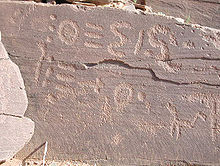
Berber orthography is the writing system(s) used to transcribe the Berber languages.
In antiquity, the Libyco-Berber script was utilized to write Berber languages. Early uses of the script have been found on rock art and in various sepulchres.[1] Usage of this script, in the form of Tifinagh, has continued into the present day among the Tuareg people.[2]
Following the spread of Islam, some Berber scholars utilized the Arabic script.[3] Excluding among the Tuareg people, the Arabic script became the dominant form of Berber orthography.[4]
The Berber Latin alphabet was developed following the introduction of the Latin script in the nineteenth century by the West.[2] The nineteenth century also saw the development of Neo-Tifinagh, an adaptation of Tuareg Tifinagh for use with other Berber languages.[5][6][7]
There are now three writing systems in use for Berber languages: Tifinagh, the Arabic script, and the Berber Latin alphabet.[8] Different groups in North Africa have different preferences of writing system, often motivated by ideology and politics.[8] With the exception of one text transcribed in Hebraic square alphabet, no other systems are known to have been used to transcribe the Berber languages.[4]
- ^ Briggs, L. Cabot (February 1957). "A Review of the Physical Anthropology of the Sahara and Its Prehistoric Implications". Man. 56: 20–23. doi:10.2307/2793877. JSTOR 2793877.
- ^ a b Elmedlaoui, Mohamed (2012). "Berber". Semitic and Afroasiatic : challenges and opportunities. Lutz Edzard. Wiesbaden: Harrassowitz. pp. 139–141. ISBN 978-3-447-06695-2. OCLC 793573735.
- ^ Ben-Layashi (2007:166)
- ^ a b Elmedlaoui, Mohamed (2012). "Berber". In Edzard, Lutz (ed.). Semitic and Afroasiatic: challenges and opportunities. Porta linguarum orientalium. Wiesbaden: Harrassowitz. pp. 140–141. ISBN 978-3-447-06695-2.
- ^ Campbell, George L. (2012). The Routledge handbook of scripts and alphabets. Christopher Moseley (2nd ed.). Milton Park, Abingdon, Oxon: Routledge. pp. 58–59. ISBN 978-0-203-86548-4. OCLC 810078009.
- ^ Aïtel, Fazia (2014). We are Imazigen : the development of Algerian Berber identity in twentieth-century literature and culture. Gainesville, FL. pp. 115–116. ISBN 978-0-8130-4895-6. OCLC 895334326.
{{cite book}}: CS1 maint: location missing publisher (link) - ^ Maddy-Weitzman, Bruce (2011). The Berber identity movement and the challenge to North African states (1st ed.). Austin: University of Texas Press. p. 75. ISBN 978-0-292-73478-4. OCLC 741751261.
- ^ a b Larbi, Hsen (2003). "Which Script for Tamazight, Whose Choice is it ?". Amazigh Voice (Taghect Tamazight). 12 (2). New Jersey: Amazigh Cultural Association in America (ACAA). Retrieved December 17, 2009.
© MMXXIII Rich X Search. We shall prevail. All rights reserved. Rich X Search
